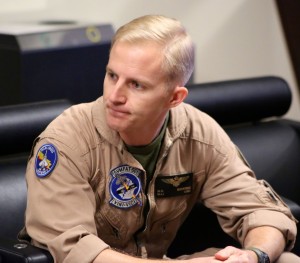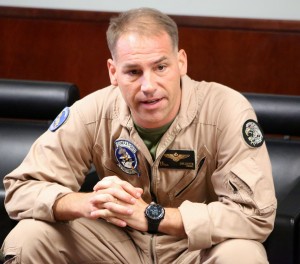Warlords Series 5: Lt. Col. Gillette Discussed IOC Process for the F-35, 2013
We discussed with the XO of the Warlords the way ahead as seen from 2013 with regard to the IOC of the F-35 and its impact on the USMC.
We first published this article on September 29, 2013 and that article follows:
During the visit of Secretary Wynne to the 33rd Fighter Wing, we accompanied him on the visit and add some meetings of our own.
Among the most notable of those additional meetings was an opportunity to sit down with two USMC leaders in the process of the roll out of the F-35B, namely with Lt. Col. Steve Gillette and Major Michael Rountree of VMFAT501.
Lt. Col. Gillette is currently the X0 of the Squadron and in transition with the jet to Yuma as the CO of Marine Fighter Attack Squadron 121 and then on to Japan with the squadron.
Major Rountree is in charge of maintenance with the squadron and an experienced Harrier pilot.
Here we discuss the roll out of the aircraft from Eglin, to Yuma and then to Japan.
The focus was upon defining what is an initial operational capability squadron and what one can expect from that IOC squadron in Japan and its impact.
SLD: How do you see the IOC of VFA-121 coming to fruition?
Lt. Col. Gillette: The Commandant has set the target as a six month window from mid 2015 to the end of 2015.
There are certain requirements that need to be met in order to successfully declare that milestone in the F-35 program.
Specifically, it will require a certain number of jets, a certain number of air group training, maintenance to support that. In addition, that the air vehicle still needs to make some more progress in terms of its developmental tests, specifically, you have aerodynamic limitations that will be lifted, you have software limitations that will be lifted that will support core competency missions.
And then lastly, weapon certification. So those three things, air vehicle, the weapon certification, and then the people piece of being trained all have to come together. Those are all projected to merge, if you will, and come to fruition mid to the end of 15.
SLD: You are doing the IOC process at Yuma and working closely with MAWTS and VMX-22. Could you talk about that dynamic?
Lt. Col. Gillette: There is no better place to IOC the F-35 than Yuma.
You have the range to support it, you have all the forward thinking It’s all right there. You’re going to have close proximity to China Lake, the Nellis ranges, which is where operational tests will be taking place. It is the perfect location to initially introduce an operational capability.
(On the Yuma triangle see the following:
http://sldinfo.com/a-new-special-report-the-ace-of-the-future-yuma-and-beyond/).
SLD: Clearly, the deployment to Japan and your first experiences with the squadron will feed back in a major way to the further development of the aircraft as well going forward. Could you discuss that process?

Lt. Col. Gillette: We’re all creatures of our experience, and so this process the initial operational squadron will go through will shape what comes next.
We will come away from the deployment with a real appreciation of exactly how we will employ this airplane across all the mission sets.
And you can speculate and draw on a board and say I think the airplane’s going to do this, and wouldn’t it be great if it could do this?
But until you actually really go out and do it, you don’t know in reality.

That’s truly where I think the light bulb — not only for the F-35 guy, but for the Marine air/ground taskforce will come on.
SLD: And the point of the deployment to Japan clearly is not just about the next iteration of the airplane. Is it not really is about the evolution of the MAGTF?
Lt. Col. Gillette: That really is the point.
Much like the unfolding of the Osprey has significantly impacted on Marine Corps thinking about the future of air assault and related missions, the roll out of the F-35B will reshape overall USMC thinking about MAGTF operations.
The airplane we will take to Japan will be an extremely capable airplane, but it’s not the end state of the airplane.
There’s no doubt in my mind that the F-35B will be more efficient and more effective than what we have know in doing the spectrum of missions which the MAGTF is configured to perform.
And the first F-35B squadron is an opening of a new era.
It is not just a new airplane; it is the beginning of a new way to integrate aircraft into USMC and joint operations.
In our DNA as Marine Corps aviators, we serve the MEU or the MAGTF commander.
When we get the F-35B squadron out into the Pacific, the further development of the aircraft will driven by the requirements set by the MEU and MAGTF commanders. We will be focusing on the development of the capabilities for the things they need needed to better support them.
SLD: In other words, engineering driven block upgrades through Block 4 are important. But after that the user groups – Marines, Navy, USAF and coalition – will be key shapers of the evolution of the aircraft?
Lt. Col. Gillette: Users will be key drivers of what comes next and our experience will be a key shaper of the future of the aircraft and its systems as well.
The featured photo shows the first flight of BF-21, USMC Tail VK-01, Yuma F-35, Pilot Billie Flynn, October 24, 2012. Credit; Lockheed Martin

